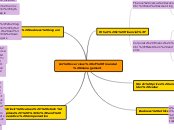by Do Trinh 7 years ago
671
chapter 1

An overview of financial management
Intrinsic values, stock prices,
and executive compensation
Equilibrium:
The situation in which the actual market
price equals the intrinsic value, so investor
are different between buyying or selling a
stock
Marginal Investor:
An investor whose veiws determine the
actual stock price
Maret Price:
The stock value based on perceived but
possibly incorrect information as see by
the marginal investor
Intrinsic Value:
An estimate of a stock's "true" value base
on accurate risk and return data
Forms of business organization
Limited Liability Partnership (LLP):
similar to LLC but used professionally
in accounting, law, architecture
Limited Liability Company (LLC):
an organization that hybrid between
a partnership and a corporatin
Corporation:
a legal entity created
by a state, separate and
distinct from its owners
and managers
C corporations:
more than 75
stockholders
S corporations:
no more than
75 stockholders
Partnership:
an unincorporated owned
by two or more people
Proprietorship:
an unincorporated business
owned by one individual
Business ethics
A Company's attitude and condutct
toward its employees, customers,
communityy, and stockholders
Stock prices and shareholder value
Primary goal for managers:
maximize the long-run of
the firm's common stock
What is financial?
Corporate Finance, Capital
Marets, and Investments
Investment relates to decision
concerning stock and bond
Market analysis
Portfolio theory
Security analysis
Capital market relates
to interest rates, stock and
bond prices
Corporate finance = Financial
management, focus on assets, capital,
and maximizing value
Finance versus economics
and accounting
Accountants provided information
size of those cash flows
Economists developed
an asset's value based
on the future cash flows

